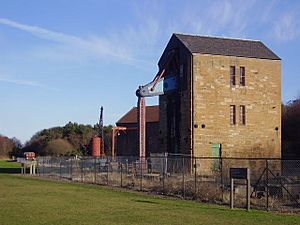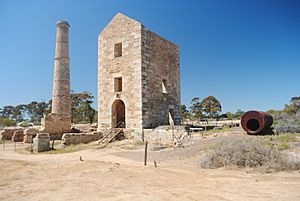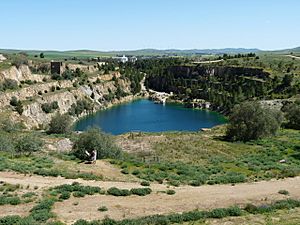Australian Cornish Mining Sites facts for kids
Quick facts for kids Australian Cornish Mining Sites |
|
|---|---|
| Type | Mining site |
| Location | Burra and Moonta |
| Governing body | Government of Australia |
| Designated | 9 May 2017 |
| Reference no. | [1] |
| Region | South Australia |
The Australian Cornish Mining Sites are important historic places in South Australia. They are listed together on the Australian National Heritage List. There are two main sites: Burra in the mid-north and Moonta Mines in the northern Yorke Peninsula. These sites are special because of their history. They were mines worked by skilled miners who came from Cornwall, a region in England. Both sites were added to the National Heritage List on May 9, 2017.
| Top - 0-9 A B C D E F G H I J K L M N O P Q R S T U V W X Y Z |
Why Were These Mines So Important?
The Start of the Copper Boom
In 1841, people found copper in places like Kapunda and Burra. Mining officially started in 1844 and 1845. By 1850, this area became the third-largest copper producer in the world! Many people, including Cornish miners and their families, moved to South Australia. They wanted to be part of this exciting "copper boom."
Later, in 1859, more copper was found in South Australia's Yorke Peninsula. New mines quickly opened in Moonta, Kadina, and Wallaroo. The area between these towns became known as the Copper Triangle. This was because so much copper was discovered there. These mines produced a huge amount of copper. It was almost half of all the minerals found in South Australia until 1924.
How Cornish People Shaped the Mines
A New Home for Cornish Miners
Cornish settlers had a big impact on the Yorke Peninsula. This is a major reason why the Moonta and Burra mines are on the National Heritage List. In the 1840s, Cornwall faced tough times. Many people left to find work, especially after a serious potato blight. Later, in the 1860s and 1870s, Cornwall's mining industry struggled. So, many Cornish miners and their families moved to Australia. They found jobs in the new copper mines.
Bringing Skills and Machines
Cornish migrants settled near the mines. They used their special skills in building, design, and mining. They even brought their own equipment, like the Cornish beam engine. These powerful engines helped pump water out of the deep mines. The Cornish steam engine was amazing for its time. It allowed miners to dig much deeper than before. The Cornish miners had skills passed down through generations. These skills were perfect for mining copper.
Thanks to the Cornish settlers, the Copper Triangle grew very fast. By 1865, over 42% of South Australia's immigrant population was Cornish. The Yorke Peninsula became known as Australia's Little Cornwall. This was because so many Cornish people lived there.
A Unique Culture in Australia
The mining towns in South Australia developed a strong Cornish culture. Cornish immigrants brought their unique way of speaking, their Methodist faith, and other traditions. The way the mines operated in Moonta and Burra was very Cornish. Even the mining words and practices were similar to those in Cornwall.
Important people like Henry Richard Hancock, who managed the mines, became very respected. This kind of social structure came from Cornwall. Over time, the Cornish immigrants started to feel like they belonged to these new mining communities. But they still kept their Cornish roots. Today, about 10% of South Australians have Cornish ancestors. There's even a festival called Kernewek Lowender (which means "Cornish Happiness"). It's held every year to celebrate the region's strong ties to Cornwall.
Moonta Mine: A Big Success Story
Life in a Growing Mining Town
Moonta was the largest mining project in South Australia during the colonial period. It is located about 165 km northwest of Adelaide. The Moonta Mines opened in 1861. They gave a big boost to South Australia's economy. In just nine years, Moonta Mines grew from four men to a community of over 10,000 people! By 1870, Moonta was the second-largest town in South Australia, after Adelaide.
With such fast growth, planning for homes and sewage was difficult. This led to crowded conditions and a lack of clean water. Water was expensive because it had to be brought in by carts. Or it was pumped from deep in the mines and cleaned. The Moonta Mining Company struggled to provide enough water. People built underground tanks to collect rainwater. However, the ground was often polluted, and these tanks could become unclean.
Managing the Mine and Its Workers
Until the 1890s, all work at Moonta mine was done by hand. Miners dug about 80 miles (130 km) of tunnels and shafts. They used ladders to go down as deep as 750 metres (2,460 ft)! Horses powered machines called "horse whims" to pull ore to the surface. Engine houses pumped water out of the mine.
Mine Captain Henry Richard Hancock managed the mine for 34 years. He worked to improve life for the workers and their families. For example, he helped set a fair minimum wage. He also started a required night school for boys who worked at the mine.
Moonta's Amazing Output
In its first year, Moonta mines produced almost 5,000 tons of ore. This was worth over 67,000 British pounds! By 1875, Moonta mine had become the largest copper region in the British Empire, even bigger than Cornwall. It was the first mine in Australia to pay out one million pounds in profits. The Moonta company produced over $10 million worth of copper in total. At its busiest, the mines employed more than 1,700 workers. The money earned from the mine was often used to help South Australia grow.
Burra Mine: The "Monster Mine"
Early Days and Big Production
The Burra mine, also known as the Burra Burra copper mine or Burra's "monster mine," was found in 1845. For its first 10 years, it was the biggest mine in Australia. The mine was owned by the South Australian Mining Association (SAMA). SAMA wanted to use the skills of Cornish workers. They hired Cornish miners and used their technology and methods. From 1850 to 1860, the mine produced five percent of the world’s copper! In 1855, at its busiest, the mine employed over 1,200 workers.
Burra is located 160km northeast of Adelaide. By 1850, it was the largest inland town. The Burra mines and their buildings are some of the oldest examples of Cornish mining and home architecture in Australia.
Working Conditions and Agreements
In September 1848, miners at Burra had disagreements with the mine owners. This happened after the superintendent, Thomas Burr, was dismissed. There were also concerns about pay and high costs for mining equipment. After some talks, the miners and SAMA reached an agreement that favored the miners.
Later in 1848, the price of copper around the world fell. Henry Ayers, from SAMA, announced a pay cut for many workers. These were workers who operated on the surface, called "grass workers." The miners went on strike again to support their fellow workers. They demanded that everyone's pay rates be restored. SAMA did not agree to this second strike. Eventually, some miners, needing work, returned, and the strike ended.
Why They Are National Heritage Sites
The Burra and Moonta mining sites were added to the National Heritage List on May 9, 2017. This was because they show important Cornish mining technology, skills, and culture. These sites are culturally valuable because of their historical importance. The Cornish miners, engineers, and tradespeople played a huge role in developing these mines. They became a major source of wealth for Australia.




